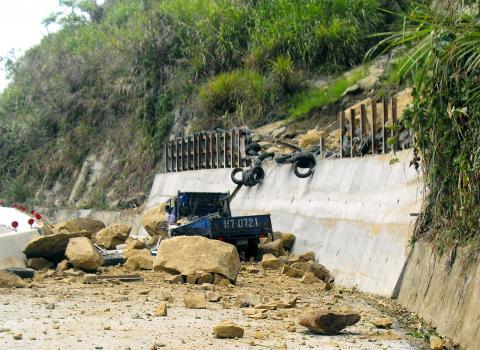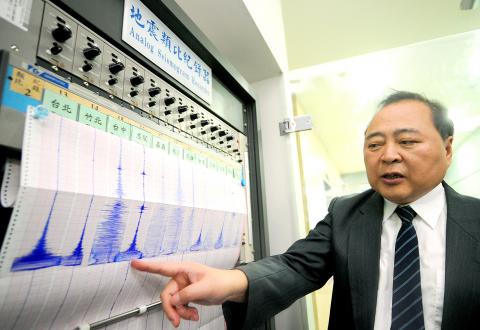One person died and 86 were injured, as of press time, after the nation was hit by a magnitude 6.1 earthquake yesterday morning.
The National Fire Agency said that a 72-year-old woman in Nantou County’s Jiji Township (集集) died after being crushed by a falling wall at Shengyuan Temple (盛元宮). The majority of the injuries were reported in Greater Taichung, with a number also occuring in Nantou County and Changhua County.
The earthquake caused a fire in Nantou County and trapped several people in elevators, the agency said.

Photo: EPA
Several schools and homes were damaged as well.
The nation’s two largest train systems — the Taiwan Railway Administration and the Taiwan High-Speed Rail Corp — were also affected by the earthquake and forced to temporarily stop or cancel some trains’ operations.
The Directorate-General of Highways said that fallen rocks were found at the 64K and 73K milestones of Highway 14 and the 24K milestone of Highway 16.

Photo: Chen Feng-li, Taipei Times
Though the nation experiences frequent earthquakes, people were nevertheless frightened by the temblor.
Television news programs aired images from surveillance tapes, showing many primary-school students in Nantou County and Greater Taichung running out of their classrooms following the earthquake.
Information from the Central Weather Bureau showed that the earthquake occurred at 10:03am and its epicenter was 38.8km east of Nantou County’s Renai Township (仁愛). It was categorized as a “very shallow earthquake,” since its center was 15.4km below the surface.

Photo: EPA
The strongest intensity caused by the earthquake was magnitude 6, which was detected at Sun Moon Lake (日月潭) in Nantou County.
The intensity measured in Nantou City, Wufong (霧峰) in Greater Taichung and Yuanlin (員林) in Changhua County reached magnitude 5.
The intensity levels detected across the rest of the nation varied between magnitudes 2 and 4.

Photo: Liu Hsin-de, Taipei Times
After the main earthquake, there were five aftershocks of magnitudes from 3.7 to 4.3.
Kuo Kai-wen (郭鎧紋), director of the bureau’s seismological center, said that yesterday’s earthquake was the largest so far this year. It was also the first earthquake this year with a magnitude exceeding 6.
Kuo added that the earthquake had occurred in a blind thrust fault that has yet to be identified in the Ministry of Economic Affairs’ Central Geological Survey.
He said that blind thrust faults are found underneath the earth’s surface and can only be detected using special scientific equipment or after earthquakes occur.
“For example, the 921 Earthquake in 1999 exposed the Chelungpu Fault (車籠埔斷層),” Kuo said.
“Since then, two major earthquakes have occurred east of Chelungpu, including a magnitude 6.7 earthquake in 2000 and a magnitude 6.15 one in 2009. Counting the one that happened yesterday, we can conclude that there is a new blind fault,” he added.
Kuo said the power released by yesterday’s earthquake was about 0.7 times the energy released when the atomic bomb was dropped in Hiroshima, which was about 1/64 that of the 921 Earthquake.

The US government has signed defense cooperation agreements with Japan and the Philippines to boost the deterrence capabilities of countries in the first island chain, a report by the National Security Bureau (NSB) showed. The main countries on the first island chain include the two nations and Taiwan. The bureau is to present the report at a meeting of the legislature’s Foreign Affairs and National Defense Committee tomorrow. The US military has deployed Typhon missile systems to Japan’s Yamaguchi Prefecture and Zambales province in the Philippines during their joint military exercises. It has also installed NMESIS anti-ship systems in Japan’s Okinawa

‘WIN-WIN’: The Philippines, and central and eastern European countries are important potential drone cooperation partners, Minister of Foreign Affairs Lin Chia-lung said Minister of Foreign Affairs Lin Chia-lung (林佳龍) in an interview published yesterday confirmed that there are joint ventures between Taiwan and Poland in the drone industry. Lin made the remark in an exclusive interview with the Chinese-language Liberty Times (the Taipei Times’ sister paper). The government-backed Taiwan Excellence Drone International Business Opportunities Alliance and the Polish Chamber of Unmanned Systems on Wednesday last week signed a memorandum of understanding in Poland to develop a “non-China” supply chain for drones and work together on key technologies. Asked if Taiwan prioritized Poland among central and eastern European countries in drone collaboration, Lin

Renewed border fighting between Thailand and Cambodia showed no signs of abating yesterday, leaving hundreds of thousands of displaced people in both countries living in strained conditions as more flooded into temporary shelters. Reporters on the Thai side of the border heard sounds of outgoing, indirect fire yesterday. About 400,000 people have been evacuated from affected areas in Thailand and about 700 schools closed while fighting was ongoing in four border provinces, said Thai Rear Admiral Surasant Kongsiri, a spokesman for the military. Cambodia evacuated more than 127,000 villagers and closed hundreds of schools, the Thai Ministry of Defense said. Thailand’s military announced that

CABINET APPROVAL: People seeking assisted reproduction must be assessed to determine whether they would be adequate parents, the planned changes say Proposed amendments to the Assisted Reproduction Act (人工生殖法) advanced yesterday by the Executive Yuan would grant married lesbian couples and single women access to legal assisted reproductive services. The proposed revisions are “based on the fundamental principle of respecting women’s reproductive autonomy,” Cabinet spokesperson Michelle Lee (李慧芝) quoted Vice Premier Cheng Li-chiun (鄭麗君), who presided over a Cabinet meeting earlier yesterday, as saying at the briefing. The draft amendment would be submitted to the legislature for review. The Ministry of Health and Welfare, which proposed the amendments, said that experts on children’s rights, gender equality, law and medicine attended cross-disciplinary meetings, adding that